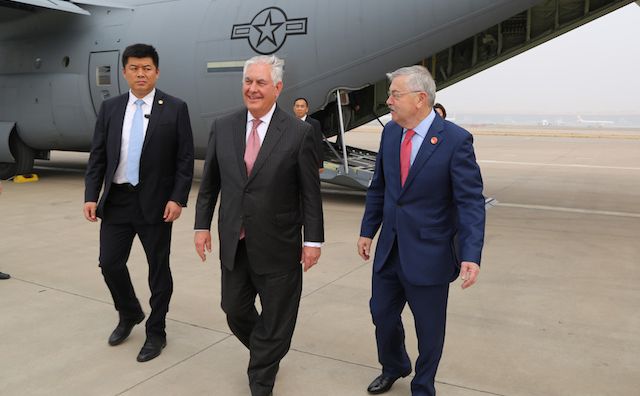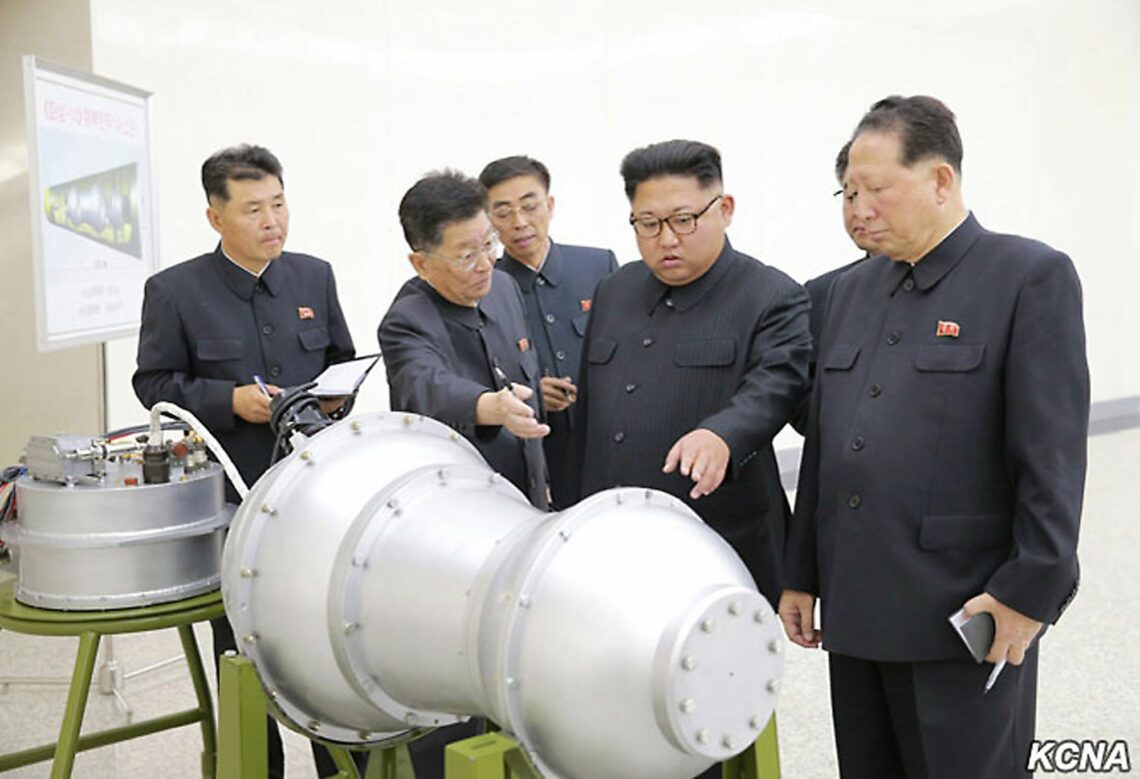2018 Global Outlook: Nuclear proliferation threat is exaggerated
The world’s existing nuclear powers are wary of proliferation, even if prospects for nuclear arms control appear to be dim. The United States, Russia, China and smaller states in possession of such arms are, at most, modernizing their arsenals.

In a nutshell
- The emerging U.S. strategy toward North Korea focuses on trying to limit the regime’s threat as a nuclear power
- While North Korea and possibly Iran advance their nuclear programs, this is not likely to lead to major proliferation
- The existing nuclear powers are modernizing their deterrents, but only China probably plans to expand its nuclear arsenal
A lot of alarmist news, hyperbolic tweets and inflammatory declarations with regard to the global nuclear arms proliferation were made in 2017. Even so, the international community is unlikely to see dramatic changes in this area soon.
Great power relations, advances in missile defense systems and regional stability are all making accelerated nuclear proliferation less likely. At the same time, prospects for significant nonproliferation or denuclearization initiatives are dim.
One trend shift in recent years has been a dramatic loss of momentum in denuclearization efforts. Much of the impetus for denuclearization had come from the United States under the presidency of Barack Obama (2009-2017). Former senior U.S. officials such as Secretary of State George P. Shultz (1984-1989) and Secretary of Defense William Perry (1994-1997) offered public support for the “road to zero” strategy, which called for established nuclear powers to spearhead efforts to reduce their dependence on strategic arsenals. President Obama had publicly embraced the concept, making denuclearization a pillar of the administration’s Nuclear Posture Review.
Failed approach
Mr. Obama signed the New START (Strategic Arms Reduction Treaty) agreement with Russia in 2011. In addition, the administration toyed with the ideas of pressing for U.S. ratification of the CTBT (Comprehensive Nuclear-Test-Ban Treaty, adopted by the United Nations General Assembly in 1996, but not entered into force as eight states have not ratified it) and renouncing the American policy of reserving the right to the “first use” of nuclear weapons. Eventually, these steps were not taken by the Obama administration.
The prospects for denuclearization do not seem to have been significantly advanced.
The election of Donald Trump all but ended the American government’s advocacy of the “road to zero.” Without the support from any nuclear power, the strategy now appears to be moribund.
Global advocacy of denuclearization continues. The United Nations in 2017 opened for signatures the world’s first legally-binding treaty prohibiting nuclear weapons. Fifty states must sign and ratify the treaty for it to take effect. To date, there are 53 signatories, but only three nations have ratified. Notably, the signatories do not include any nuclear power or NATO member. The prospects for denuclearization do not seem to have been significantly advanced by this mostly symbolic initiative.
While the size of the nuclear club is unlikely to shrink in the near future, the odds of nuclear proliferation expanding globally remain low. The most significant threats of proliferation are North Korea and Iran.
Two difficult actors
In recent years, North Korea has made dramatic progress in its weapons programs in both nuclear device testing (including to the detonation of what is widely believed to be a fusion thermonuclear bomb) and in ballistic missile development. The emerging U.S. response, while unlikely to constrain North Korea’s proliferation effort, is concentrated on containing and limiting the regime’s threat as a nuclear power. The U.S. strategy includes missile defenses, strategic and conventional deterrence and heavy sanctioning. It does not limit the regime’s ability to develop a functional nuclear arsenal, but aims to neutralize the threat by providing the U.S. and its allies with adequate defenses against any potential attack.
Meanwhile, the administration reported to Congress that it had certified Iran’s compliance with the Joint Comprehensive Plan of Action (commonly called the Iran deal or Iran nuclear deal), an international agreement intended to provide safeguards against the development of nuclear weapons by Iran, for the last time. This leaves the status of the agreement uncertain after 120 days. However, Washington’s eventual withdrawal from the JCPOA would not necessarily mean that Tehran would immediately pursue a nuclear “breakout” option. The U.S. strategy includes efforts to increase missile defense, support for regional alliances and further sanctions to constrain the regime.

Firm U.S. actions against North Korea and Iran will likely reassure friends and allies while discouraging other countries from pursuing their own nuclear weapons programs. Both Washington and Seoul, for example, have rejected calls for reintroducing tactical nuclear weapons in South Korea. Meanwhile, Japan has signaled that it intends to restrict its defense buildup to conventional forces only. The stiffening of U.S. policies toward Iran also makes it far less likely that Saudi Arabia, Turkey or Egypt will find it necessary to develop independent nuclear deterrents – even if Iran does elect to conduct a nuclear breakout. Nor is it inevitable that if Iran revives its nuclear program, Israel will automatically seek to significantly expand its strategic deterrent.
While Iran and North Korea may continue to advance their nuclear programs, there is less likelihood that they will engage in successful proliferation activities beyond active technical cooperation with each other.
Nuclear superpowers
Likewise, prospects are small that the U.S., Russia or China will change the trajectories of their deterrence postures. Russia has committed to modernizing its nuclear forces over the last several years. The U.S. will probably follow suit.
It is possible that the U.S. and Russia might consider a follow-up on the New START.
Of the three nuclear deterrence strategies, China’s is the opaquest and remains a subject of debate in the West. In the past, China maintained a relatively small nuclear arsenal in comparison to those of its potential adversaries. It is, however, in the process of fielding next-generation systems that include missiles with multiple, independent reentry warheads. “If history is any guide, China is likely to build up its arsenal in a cautious, methodical manner. Nonetheless, it is undeniable that China’s nuclear arsenal is going to get larger in the years ahead, and U.S. nuclear and arms-control strategy must account for this fact,” concluded The National Interest’s Zachary Keck in a recent analysis.
As for the U.S., the new Nuclear Posture Review will likely reverse the Obama administration’s policy of de-emphasizing American reliance on a strong nuclear deterrent. The country already has committed to a new generation of SSBNs (fleet ballistic missile submarines) and a replacement for its aged strategic bombers. Washington is likely to pursue additional initiatives in the years to come, possibly including a new class of theater nuclear forces.
In short, none of the major powers looks inclined to diminish its reliance on nuclear weapons or de-emphasize strategic deterrence. That said, the prospects for future arms control agreements are not completely off the table. While strategic arms negotiations with China are unlikely, it is possible that the U.S. and Russia might consider a follow-up on the New START.
Other players
The other nuclear-capable Western nations, France and Great Britain, will retain but not significantly modify their deterrence systems in the near term.
The nuclear relationship between Pakistan and India is dynamic. In November 2017, India conducted a successful test flight of its nuclear-capable Nirbhay cruise missile. The country is suspected of also developing a homegrown ballistic missile defense. Meanwhile, Pakistan is estimated to have a larger nuclear arsenal than India and remains a concern for proliferation. Both Pakistan and India treat nuclear deterrence as cornerstones of their defense policies. Yet, their strategic postures are evolving.
India is aligning more closely with the U.S. and sees itself, in partnership with Washington, as a regional counterweight to China. Meanwhile, Pakistan has sustained a strategic relationship with the U.S. while significantly expanding its economic and diplomatic links with China. This evolution in the South Asian security framework makes nuclear confrontation less likely. As the two states align with the interests of the more powerful U.S. and China, they come under a significantly expanded umbrella of nuclear deterrence.
Scenarios
The most probable future scenarios suggest that the potential for a nuclear conflict is receding globally. This reality stands in contrast to news media coverage that tends to hype confrontations between the current and aspiring nuclear powers. Expect the global consensus against proliferation to expand and strengthen, but various efforts to expand initiatives for denuclearization to fail.
Further, the biggest nuclear powers – the U.S., Russia and China – will continue to expand and modernize their arsenals. Lastly, one can expect an expansion of missile defense technology and a greater reliance of nuclear-capable powers on “protect-and-defend” strategies. This combination of nuclear deterrence and missile defense is now seen as the most stable defense posture in an already proliferated world.







